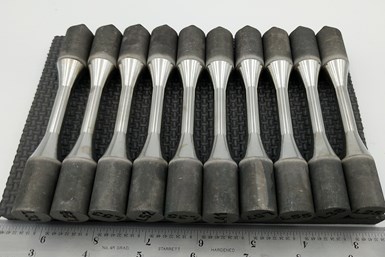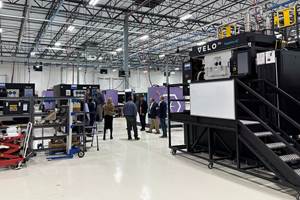Pulsed Electrochemical Machining as Postprocessing for AM
Pulsed electrochemical machining is a production metal AM-ready form of postprocessing with short cycle times and long tool life.

Metal additive manufacturing can create previously impossible geometries, but some fields require more precise surface finish and smaller walls than the technology can currently create. Postprocessing techniques like pulsed electrochemical machining can fulfill these requirements while enabling manufacturers to benefit from AM. Image courtesy of Voxel Innovations.
Metal additive manufacturing (AM) is excellent for achieving near-net manufacturing of parts, but is not without its limitations. High material costs, limitations on minimum wall thickness and limitations on resolution pose issues for production AM and manufacturing of tight-tolerance parts in the aerospace or medical industries. Postprocessing can address these issues, but postprocessing methods have to mesh with the geometric complexity of additive parts. Pulsed electrochemical machining (PECM) is one promising postprocessing technique for realizing smooth surface finishes and fine material removal within higher volume AM applications.
How PECM Works
PECM utilizes electrochemistry rather than heat or friction to dissolve the workpiece metal. It works via an electrolytic fluid within a small gap between the tool (cathode) and workpiece (anode). A pulsed current removes the workpiece material at a rate proportional to its proximity to the cathode. This cathode ultimately serves as the inverse of the desired shape on the workpiece.
The electrolytic fluid serves two important purposes. Primarily, it functions as the conductor for the electrochemical reaction that actively dissolves the workpiece. Secondarily, the electrolytic fluid flushes out waste products and eliminates any residual heat that might otherwise affect the local conductivity of the electrolyte. The PECM process leaves the part with a smooth, burr-free finish.
PECM is a no-contact process. This means there is no tool wear, and the PECM tool has a theoretically infinite life span whereby it can machine thousands of parts without compromising the integrity of the machining process. The PECM process also does not introduce stress into the workpiece, nor does it create recast layers, microcracks or other surface changes.
PECM as a Secondary Machining Process
Most metal 3D printers can achieve a minimum wall thickness of around 0.3 - 0.5 mm (0.012 - 0.020 inch), which does not pose an issue for most applications. However, for critical components requiring high precision and tight tolerances, additive manufacturing cannot work alone. By utilizing PECM as a secondary process, the minimum wall thickness of metal 3D printed parts can be reduced to less than 50 µm and high-resolution features can be added to the near-net additive part.
Although the cost of cathode design iteration means PECM is not a great solution for one-off or low-volume parts, metal AM is transitioning into volume production applications where the per-part costs are critical. Thicker layer lines, larger powders, faster laser scan strategies and more aggressive recoater methods can all reduce metal AM costs at the expense of resolution, surface finish and feature size. To ensure these less-expensive AM processes continue to meet client needs, manufacturers can incorporate a secondary machining process like PECM. Combining a faster, but rougher, metal AM process with PECM to correct geometry and add critical features can create a part that is not only cheaper but also higher performance.
One example of PECM’s benefits as a secondary machining process involves a nickel-superalloy aerospace turbine blade. Using PECM improved the part’s performance via thinner trailing edges on the blades and smoother surface quality. To achieve high-volume production, PECM simply reuses the same cathode, thereby achieving identical results for potentially thousands of parts.

Pulsed electrochemical machining can selectively finish sections of a part while leaving others rough. This capability proves particularly useful for aerospace and medical applications. Image courtesy of Voxel Innovations.
Selective Surface Finishing of AM Parts
While AM’s inability to produce microscopically smooth surfaces does not affect the performance of most 3D printed parts, attaining ultrasmooth surface quality may enhance the capabilities of certain parts.
Surface irregularities on additively manufactured parts can arise due to layer lines, powder particle size, remelted material or remnants of the removed support structures. These surface irregularities cause unnecessary friction, impede the ability to inspect the parts for structural cracks, and can lead to fatigue or corrosion failures — all of which can reduce the lifetime or performance of a critical AM component.
Microchannel heat exchangers for aerospace engines exemplify the sort of part that requires exceptionally smooth surface finishes. Additive manufacturing is often an ideal way to produce these parts from advanced materials. However, problems arise due to standards requiring aerospace components to be able to withstand enormous temperature fluctuations. The surface quality of heat exchangers is directly related to their ability to effectively transfer heat, and additive manufacturing has not matured enough to meet this quality requirement. By using electrochemical machining as a secondary finishing process, PECM can improve the surface finish where advantageous while retaining surface roughness where greater surface friction is required.
According to data from Voxel Innovations, PECM can improve the surface quality of metal 3D printed parts from 5-10 µm (196-393 µin) Ra to less than 0.5 µm (19.6 µin), even to 0.1 µm (3.9 µin) Ra. The surface finishing process is also quick compared to more conventional methods of machining microscopic channels and can be identically replicated tens of thousands of times without wearing down the tool.
Another specific example can be found in medical implant manufacturing. Femoral stems are orthopedic implants that attach a ball joint to the patient’s hip. Problems arise at the finishing stage; certain areas of this device must have an ultra-smooth surface, as friction must be diminished to promote proper joint movement and minimize patient discomfort. However, other features of the femoral stem should promote osseointegration, a phenomenon where the implant fuses itself with the bone to promote stability and prevent further fractures. These surfaces should be rough and porous to promote easier fusion with the bone. These two contrasting surface qualities must exist within the same part. PECM enables selective finishing of the femoral stem in one singular machining process while retaining the benefits of the osseointegration features produced by metal AM.
Related Content
DMG MORI: Build Plate “Pucks” Cut Postprocessing Time by 80%
For spinal implants and other small 3D printed parts made through laser powder bed fusion, separate clampable units resting within the build plate provide for easy transfer to a CNC lathe.
Read MoreHow Machining Makes AM Successful for Innovative 3D Manufacturing
Connections between metal 3D printing and CNC machining serve the Indiana manufacturer in many ways. One connection is customer conversations that resemble a machining job shop. Here is a look at a small company that has advanced quickly to become a thriving additive manufacturing part producer.
Read More8 Cool Parts From Formnext 2023: The Cool Parts Show #65
New additive manufacturing technologies on display at Formnext were in many cases producing notable end-use components. Here are some of the coolest parts we found at this year’s show.
Read MoreZeda AM Production Plant in Ohio Now Open — Thoughts on the New Facility
73,000-square-foot metal powder bed fusion plant includes extensive machining capability plus separate operational models for serving medical versus other businesses.
Read MoreRead Next
Postprocessing Steps and Costs for Metal 3D Printing
When your metal part is done 3D printing, you just pull it out of the machine and start using it, right? Not exactly.
Read MoreBike Manufacturer Uses Additive Manufacturing to Create Lighter, More Complex, Customized Parts
Titanium bike frame manufacturer Hanglun Technology mixes precision casting with 3D printing to create bikes that offer increased speed and reduced turbulence during long-distance rides, offering a smoother, faster and more efficient cycling experience.
Read MoreProfilometry-Based Indentation Plastometry (PIP) as an Alternative to Standard Tensile Testing
UK-based Plastometrex offers a benchtop testing device utilizing PIP to quickly and easily analyze the yield strength, tensile strength and uniform elongation of samples and even printed parts. The solution is particularly useful for additive manufacturing.
Read More




















